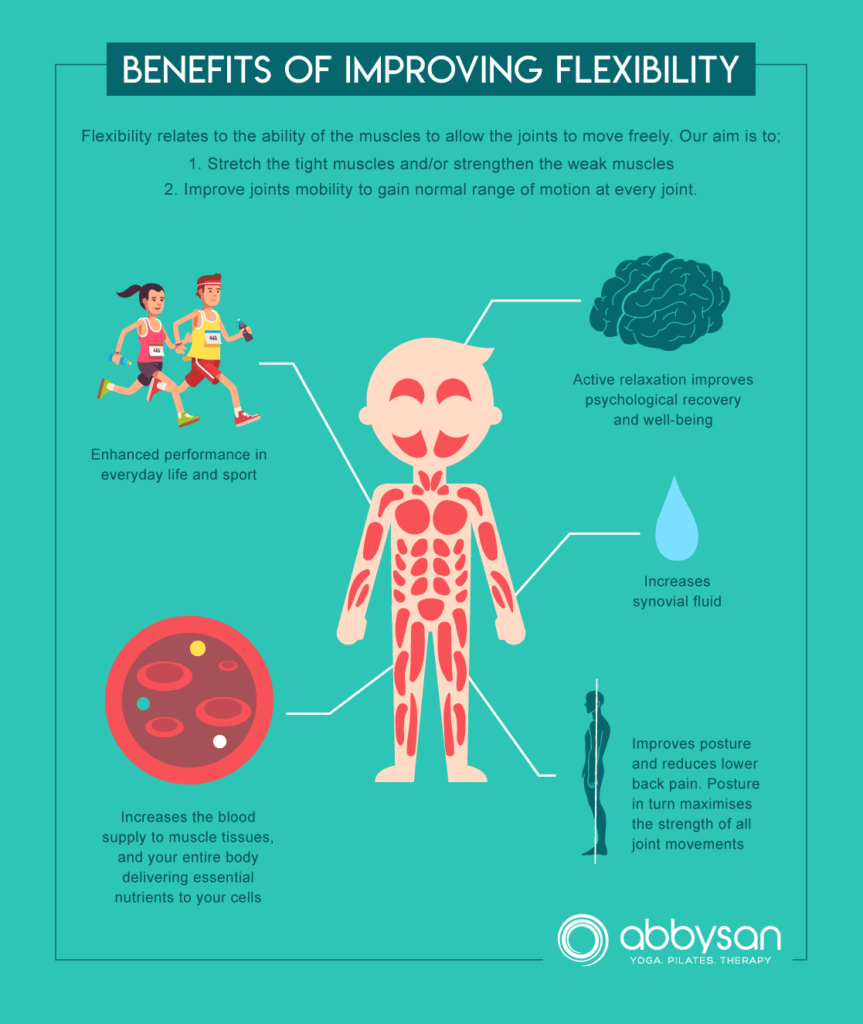Flexibility relates to the ability of the muscles to allow the joints to move freely.
Flexibility is often used as synonyms to Joint motion. To achieve optimium flexibility required for the functional movement on everyday basis we require to aim the following.
- Stretch the tight muscles and/or strengthen the weak muscles
- Improve joints mobility to gain normal range of motion at every joint.
Purpose of Improving Flexibility
- Improved flexibility may enhance performance in aerobic training and muscular conditioning as well as in sport.
- Flexibility training used in yoga postures helps in active relaxation that can improve both mental and physical recovery.
- Reduces stress in the exercising muscles and releases tension developed during the workout.
- Assists with posture by balancing the tension placed across the joint by the muscles that cross it. Proper posture minimizes stress and maximizes the strength of all joint movements.
- Reduces the risk of injury during exercise and daily activities because muscles are more pliable.
- Improves performance of everyday activities as well as performance in exercise and sport.
Techniques for Improving Flexibility
Joint mobilisation techniques:
By improving your range of motion, your body requires less energy to make the same movements and you also will have more flexible joints thus lessening the likelihood of injuries sustained during workouts, or any other time.
Stretching techniques:
Recent research has shown that static stretching can reduce muscle soreness after exercise. These slow, gradual movements involve a controlled elongation of the muscle through it’s full range of motion, and is then held for 15-30 seconds in the farthest position that can be held without pain. By stretching in this way, you can improve muscular balance and your resting posture.
Fascial release techniques:
Applying compression to the affected site induces a bio-electric and bio-chemical response that changes the connective myo-fascia from a semi-solid state into a more viscous or fluid state, freeing it to glide smoothly against adjoining tissues. Often, once the fascia is released the underlying muscles will relax.
All types of flexibility training will be more effective after a thorough warm-up, when the body temperature is elevated. Choose activities that serve two functions: relaxation and flexibility. This does not mean that the entire time has to be spent stretching.
Methods of Improving Flexibility
Methods of Improving Flexibility
- Yoga
- Pilates
- Tai Chi
- Hydro-therapy
- Manipulative Therapy
One of the most notable benefits of theses methods is that it promotes muscular relaxation and because of this, can lessen lower back pain. Since those muscles are commonly contracted throughout the day, whether sitting or doing activities, they can become stressed and cause pain. Becoming more flexible in the hamstrings, hip flexors, quadriceps and other muscles can help reduce that stress on the lower back and reduce the tightening that causes pain.
Yoga and pilates also increases the blood supply to muscle tissues, and your entire body delivering essential nutrients through your blood stream. It also increases joint synovial fluid, the lubricating fluid that promotes the transportation of nutrients to your joints. This allows for a greater range of motion, less joint pain and a reduced risk of joint degeneration.
Better Overall Health and Vitality can be achieved through above methods. You will notice less pain, improved movement, reduced muscle soreness, and improved physical performance. The feeling of well-being, and vitality you will notice as a result of a regular flexibility routine can provide many important health benefits.
“Stretching is not just a part of a workout, it can be a workout by itself.”

